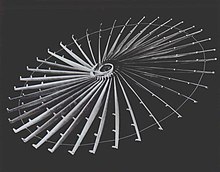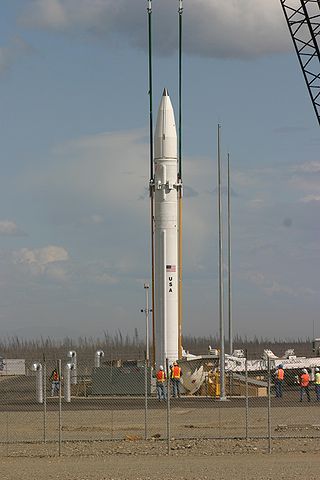
An anti-ballistic missile (ABM) is a surface-to-air missile designed to counter ballistic missiles. Ballistic missiles are used to deliver nuclear, chemical, biological, or conventional warheads in a ballistic flight trajectory. The term "anti-ballistic missile" is a generic term conveying a system designed to intercept and destroy any type of ballistic threat; however, it is commonly used for systems specifically designed to counter intercontinental ballistic missiles (ICBMs).

A missile is an airborne ranged weapon capable of self-propelled flight aided usually by a propellant, jet engine or rocket motor. Historically, 'missile' referred to any projectile that is thrown, shot or propelled towards a target; this usage is still recognized today with any unguided jet- or rocket-propelled weapons generally described as rocket artillery. Airborne explosive devices without propulsion are referred to as shells if fired by an artillery piece and bombs if dropped by an aircraft.

The Strategic Defense Initiative (SDI), nicknamed the "Star Wars program", was a proposed missile defense system intended to protect the United States from attack by ballistic strategic nuclear weapons. The concept was announced on March 23, 1983, by President Ronald Reagan, a vocal critic of the doctrine of mutually assured destruction (MAD), which he described as a "suicide pact". Reagan called upon American scientists and engineers to develop a system that would render nuclear weapons obsolete. Elements of the program reemerged in 2019 with the Space Development Agency (SDA).

A shaped charge is an explosive charge shaped to focus the effect of the explosive's energy. Different types of shaped charges are used for various purposes such as cutting and forming metal, initiating nuclear weapons, penetrating armor, or perforating wells in the oil and gas industry.

A kinetic energy penetrator (KEP), also known as long-rod penetrator (LRP), is a type of ammunition designed to penetrate vehicle armour using a flechette-like, high-sectional density projectile. Like a bullet or kinetic energy weapon, this type of ammunition does not contain explosive payloads and uses purely kinetic energy to penetrate the target. Modern KEP munitions are typically of the armour-piercing fin-stabilized discarding sabot (APFSDS) type.

Reactive armour is a type of vehicle armour used in protecting vehicles, especially modern tanks, against shaped charges and hardened kinetic energy penetrators. The most common type is explosive reactive armour (ERA), but variants include self-limiting explosive reactive armour (SLERA), non-energetic reactive armour (NERA), non-explosive reactive armour (NxRA), and electric armour. NERA and NxRA modules can withstand multiple hits, unlike ERA and SLERA.

Armour-piercing ammunition (AP) is a type of projectile designed to penetrate armour protection, most often including naval armour, body armour, vehicle armour.

A projectile is an object that is propelled by the application of an external force and then moves freely under the influence of gravity and air resistance. Although any objects in motion through space are projectiles, they are commonly found in warfare and sports.
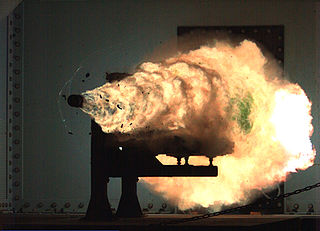
A railgun or rail gun is a linear motor device, typically designed as a weapon, that uses electromagnetic force to launch high-velocity projectiles. The projectile normally does not contain explosives, instead relying on the projectile's high kinetic energy to inflict damage. The railgun uses a pair of parallel conductors (rails), along which a sliding armature is accelerated by the electromagnetic effects of a current that flows down one rail, into the armature and then back along the other rail. It is based on principles similar to those of the homopolar motor.

High-explosive anti-tank (HEAT) is the effect of a shaped charge explosive that uses the Munroe effect to penetrate heavy armor. The warhead functions by having an explosive charge collapse a metal liner inside the warhead into a high-velocity shaped charge jet; this is capable of penetrating armor steel to a depth of seven or more times the diameter of the charge. The shaped charge jet armor penetration effect is purely kinetic in nature; the round has no explosive or incendiary effect on the armor.

A ranged weapon is any weapon that can engage targets beyond hand-to-hand distance, i.e. at distances greater than the physical reach of the user holding the weapon itself. The act of using such a weapon is also known as shooting. It is sometimes also called projectile weapon or missile weapon because it typically works by launching solid projectiles ("missiles"), though technically a fluid-projector and a directed-energy weapon are also ranged weapons. In contrast, a weapon intended to be used in hand-to-hand combat is called a melee weapon.
Kill vehicle is a term from space weapon development and science fiction which denotes either a kinetic projectile or an explosive warhead supposed to impact on or near a target. It is the final missile stage of an interceptor weapon.
A kinetic bombardment or a kinetic orbital strike is the hypothetical act of attacking a planetary surface with an inert kinetic projectile from orbit, where the destructive power comes from the kinetic energy of the projectile impacting at very high speeds. The concept originated during the Cold War.
The XM1111 Mid-Range Munition (MRM) is a 120 mm precision guided munition developed for the Rheinmetall Rh-120 120mm gun used by several Western tanks. It was also intended to fulfill a requirement for Future Combat Systems (canceled) for a long-range, beyond line of sight (BLOS) tank munition.
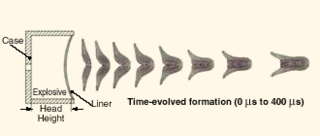
An explosively formed penetrator (EFP), also known as an explosively formed projectile, a self-forging warhead, or a self-forging fragment, is a special type of shaped charge designed to penetrate armor effectively, from a much greater standoff range than standard shaped charges, which are more limited by standoff distance. As the name suggests, the effect of the explosive charge is to deform a metal plate into a slug or rod shape and accelerate it toward a target. They were first developed as oil well perforators by American oil companies in the 1930s, and were deployed as weapons in World War II.
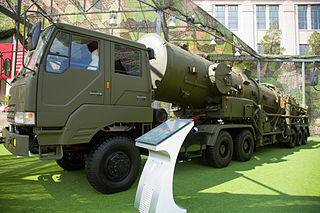
The Dong-Feng 21 (DF-21; NATO reporting name CSS-5 - Dong-Feng is a two-stage, solid-fuel rocket, single-warhead medium-range ballistic missile in the Dong Feng series developed by China Changfeng Mechanics and Electronics Technology Academy. Development started in the late 1960s and was completed around 1985–86, but it was not deployed until 1991. It was developed from the submarine-launched JL-1 missile, and is China's first solid-fuel land-based missile. The U.S. Department of Defense in 2008 estimated that China had 60-80 missiles and 60 launchers; approximately 10-11 missiles can be built annually.

The Lazy Dog is a type of small, unguided kinetic projectile used by the U.S. Air Force. It measured about 1.75 inches (44 mm) in length, 0.5 inches (13 mm) in diameter, and weighed about 0.7 ounces (20 g).

Ammunition is the material fired, scattered, dropped, or detonated from any weapon or weapon system. Ammunition is both expendable weapons and the component parts of other weapons that create the effect on a target.

A hypersonic glide vehicle (HGV) is a type of warhead for ballistic missiles that can maneuver and glide at hypersonic speed. It is used in conjunction with ballistic missiles to significantly change their trajectories after launch. The concept of HGVs is similar to MaRVs, but HGVs are separated from their rocket boosters shortly after launch as opposed to MaRVs which can only maneuver just before the impact. Conventional ballistic missiles follow a predictable ballistic trajectory and are vulnerable to interception by the latest anti-ballistic missile (ABM) systems. The in-flight maneuverability of HGVs makes them unpredictable, allowing them to effectively evade air defenses. As of 2022, hypersonic glide vehicles are the subject of an arms race.

The Exoatmospheric Reentry-vehicle Interceptor Subsystem, or ERIS, program, was a component of the United States' Strategic Defense Initiative during the Cold War. The ERIS system was named after Eris, Greek goddess of strife. ERIS was a kinetic kill system, launched from a ground-based system, and impacting directly to destroy an incoming Intercontinental ballistic missile (ICBM) before the targeted ICBM re-entered the Earth's atmosphere.
